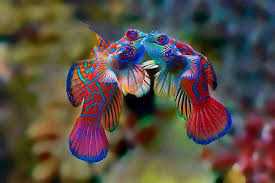How to keep Mandarin Fish healthy the easy way.
Here you have the most comprehensive info on keeping and breeding Mandarin fish.
Mandarin fish facts and Mandarin fish care and all the truth about keeping Mandarin fish in the home aquarium tank.
Mandarin Dragonet or Mandarin Goby (Synchiropus splendidus).
Mandarin fish care and Mandarin fish food.
Live Copepods and Amphipods are the best mandarin fish food. Minimal time involved. Get Both Tisbe Copepods and Live Saltwater Amphipods to keep your Mandarin fish happy and healthy.
Seed your refugium and display tank as well with live forage animals.
Spend your time enjoying the beautiful Mandarin Dragonet fish instead of worrying about getting mandarin fish food for the fish's needs and health.
You can accomplish this by understanding and following a few easy steps and take the worry out of keeping Mandarin fish.
1. Subscribe to bi- weekly or monthly automatic recurring deliveries of live Amphipods and Live Copepods, Tigger Pods and Tisbe Copepods Mix.
Best pods for Mandarins to eat. Feed live Amphipods and Copepods Tisbe to Mandarin fish and seahorses.
Mandarin fish and Seahorses are live prey grazers, which means they need to eat live food all day. Feeding them once or twice a day is not sufficient for Mandarin fish to stay healthy in your reef tank. Doesn't hurt to periodically feed some of our concentrated non live foods such as Arctic Pod Feast Copepods, and Salmon Egg Delight fish eggs. When Mandarin fish are healthy and comfortable in the aquarium there is the possibility that they can learn to eat some non live foods to supplement their live food intake.
2. Provide a habitat that is as close to the natural environment that Mandarin fish have evolved to live and thrive in for thousands of years.
Here your emphasis should be on the needs of the Mandarin fish’s prey animals.
You can never have too many hiding places in small rock crevices and Macro Algae like Chaetomorpha (Chaeto). This environment will provide a home for the Amphipods and Copepods so they can establish breeding colonies in the aquarium and seed your refugium.
It’s important for these Mandarin fish and there prey animals to be able to co-exist in your reef tank aquarium together as they do in the wild.
3. Feed your Copepod and Amphipod populations.
Amphipods and benthic Copepods like Tisbe Copepods and Tigger Pods are scavengers and easy to feed. They come out at night and will eat left over food from the substrate and rocks. Providing the added benefit of a micro clean up crew as well.
With this in mind, if you plan your tank setup carefully, you can achieve longevity and health in your Mandarin fish. Together with regular infusions of live Zooplankton Amphipods and Copepods.
There are other type of fish that benefit in this same type of habitat.
Green Mandarin, Blue Mandarin, Psychedelic Mandarin, Red Mandarin, Spotted Mandarin.
Scooter Blenny, Ocellated dragonet . Starry dragonet, stellate dragonet, ruby dragonet, red scooter blenny.
And of course Seahorses of all kinds love live Amphipods and Amphipods provide a healthy diet as well.
Mandarin fish need at least a 50 gallon tank or larger per individual fish.
The truth is that it's difficult to keep a Mandarin in a small 29 gallon tank but not impossible. You need hiding places for the Pods. Rock crevices and or some macro algae like chaeto. This allows the pods to escape predation long enough to breed before they get eaten by the Mandarin fish. The Mandarin won't eat the adults so that's a good thing but since it's a small tank the fish can hunt down and eat all the babies and juveniles faster than your adult Pods can produce them. So either have some hiding places for the Pods or keep on feeding pods to the tank on a regular basis. Even with hiding places you still need to replenish every once in a while. This isn't a love em and leave em situation.
When you observe the Mandarin it spends the entire day picking at food, which means it's constantly eating like a grazing animal. So even though it looks small in size it doesn't have a large stomach so it has to eat constantly. Which indicates that it needs more than 100 pods to survive in a 29 gallon tank. Count how many times a healthy Mandarin picks at something per every 5 minutes then multiply by hours in the day. Although it wont eat the 100 adults, eat will eat all the babies that a hundred pods produce faster than they can produce them per week.
You might have gotten a Mandarin fish that had already passed the starvation faze when it's almost impossible to bring it back to eating regular. I don't know how long you had it and if you saw it eating regularly before it died.
